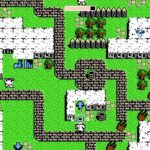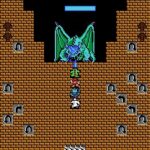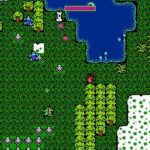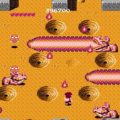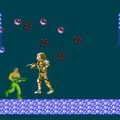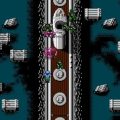Developer: Square/Workss Publisher: Square Released: 09/89 Genre: Action
Square Enix is the Japanese role-playing game powerhouse in Japan. It is a reputation that is well deserved as they put in the work over these last thirty years to earn that designation. But it is interesting to look back on their early output before they found their footing. You have racing games like Rad Racer, platformers like 3-D World Runner and even shooters like Thexder. One early title no one speaks of is King’s Knight. This experimental shooter has some interesting ideas but it too obtuse for its own good. While I would not say it is outright bad it isn’t good either.
King’s Knight is the first game published by Square in the US but not their first developed. Princess Claire has been kidnapped by the kingdom of Izandor and now four heroes have stepped up to save her. While they all begin their quest alone in the end they will team up to defeat the evil dragon Tolfida and rescue the princess.
Even though it may seem to have the trappings of an RPG (and it does) King’s Knight is a vertically scrolling shooter like Dino Riki. The game has five chapters. In the first four you control one of four characters; Ray Jack the Knight, Kaliva the Wizard, Barusa the Monster, and Toby the Thief. Each hero has a basic attack until the final chapter and can jump on parts of the environment by pressing up against it. Other obstacles can still crush you but the game generally does a good job designating which objects are impenetrable. Nearly every part of the terrain is destructible and full of much needed power-ups.
While their basic attacks are more or less the same all four heroes have stats and specialize in a particular category. Barusa is physically the strongest and takes less damage than the rest. Ray Jack is the strongest while Kaliva the Wizard can navigate the environment better thanks to his jumping prowess. The overabundance of power-ups is to level up each character, up to a maximum of twenty. These include much needed weapon increases, better defense, speed and jumping ability. The difference is almost immediately noticeable after a few pick-ups and necessary as you start out a gimp. To balance this out there are also power downs, some in places where it is necessary to take the hit to collect mandatory quest items.
Every hero has their own individual level. These serve as both a training ground to build up their stats but also to find key quest items. The game does not make it explicit but there is a quest to complete. Each character has a corresponding element that you must collect. These elements are broken into four pieces and are hidden anywhere in each level, forcing you to destroy everything in the environment. At least one or two pieces of each element are in hidden caves in each level. The problem is the game does not communicate this in any fashion. You need these elements for the final level but if you miss even one you have to redo that character’s level. That is the least of the game’s problems.
For the final chapter King’s Knight tries to do something different. Here you control all four characters simultaneously and need to make use of their individual abilities to reach the end. The heroes take up a cross formation and you can switch the lead by stepping on special pads throughout the stage. If it sounds unintuitive that is because it is but the finale’s issues go even deeper.
Controlling four characters simultaneously does not work. Everyone shares one life bar and moving as a group to avoid damage is nearly impossible. I’ve mentioned the elements necessary to complete this last stage. Unfortunately this version lacks the UI of the MSX game that kept track of everything you have collected. If you missed one item you have to figure out which on your own. You must use the special abilities from the elements in specific areas during the final level. But the game gives “hints” so vague I refuse to believe anyone deciphered it on their own. Even worse you need specific characters in the lead to progress at certain points. If you miss the switch tiles than guess what, you’re screwed. And I haven’t explained the steps needed to beat the final boss! Someone was too clever for their own good and the game suffers for it.
In Closing
King’s Knight is average at best. Its heart is in the right place but it is frustrating and flawed. I like it to an extent as it at least tried something different for a shooter. But its execution is lacking. This is a footnote in Square’s history for a reason.


